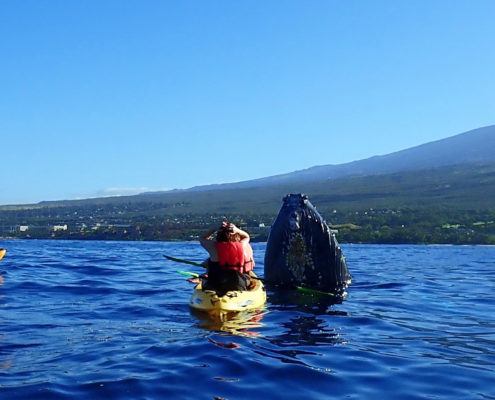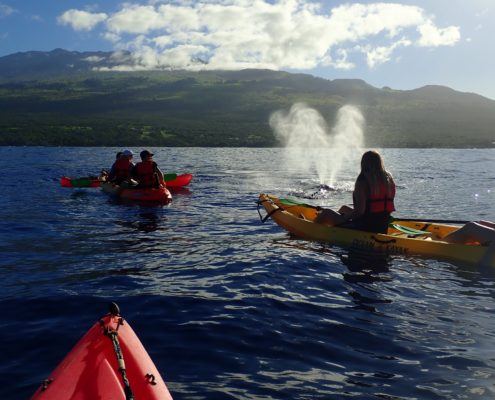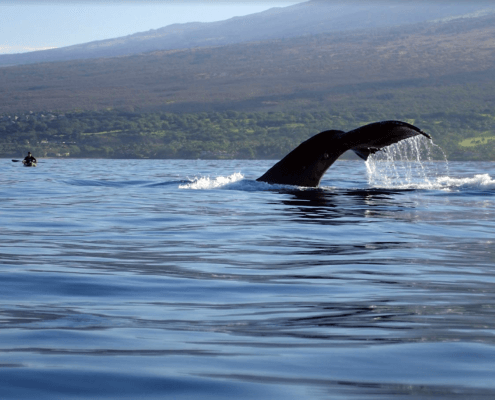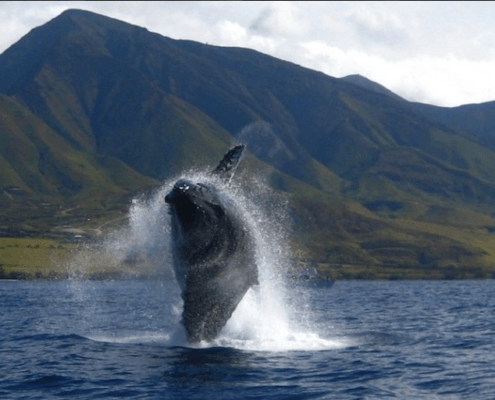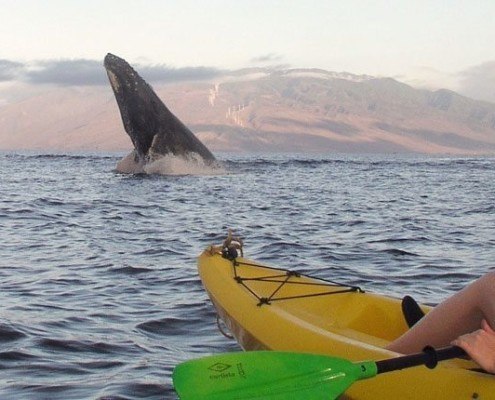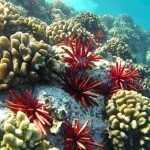On Monday, January 8th, Maui Kayak Adventures Guide Matt Robson paddled out from Makena Landing, located on the south side of Maui, to lead a group whale watching tour. Though this was not Matt’s first foray into leading whale watching tours, it quickly became apparent that this would be the most memorable. A very curious juvenile whale made its way over to the kayaks to investigate.
You got Mugged By A Pirate On The High Seas?
No, they didn’t get robbed by pirates and in fact, they were given what is possibly the most magical moment of their lives. Maui is within the Hawaiian Island Humpback Whale National Marine Sanctuary. There are a number of laws that were enacted in the area so as to protect the migrating humpback whale population. One of those laws requires boats to stay a minimum of 100 yards (imagine a football field) away from a whale. If the whale wants to come toward you, it’s their prerogative, but boats are required to idle or remain still, and this is what we refer to as “getting mugged.” This particular juvenile whale got up close and personal.
The occurrence in Sydney’s video is super rare, and though the behaviors exhibited by the juvenile are not usually so up close and personal, they are common. We are going to break them down for you.
The following photos were taken by guide Matt Robson, as Maui Kayak Adventures provides complimentary photos for all of its guests as part of every kayak tour. The underwater photos were taken with an Olympus TG5 aimed off the side of the kayak — the whale did all of the work, but we might change Matt’s job title to, “Whale Whisperer”.
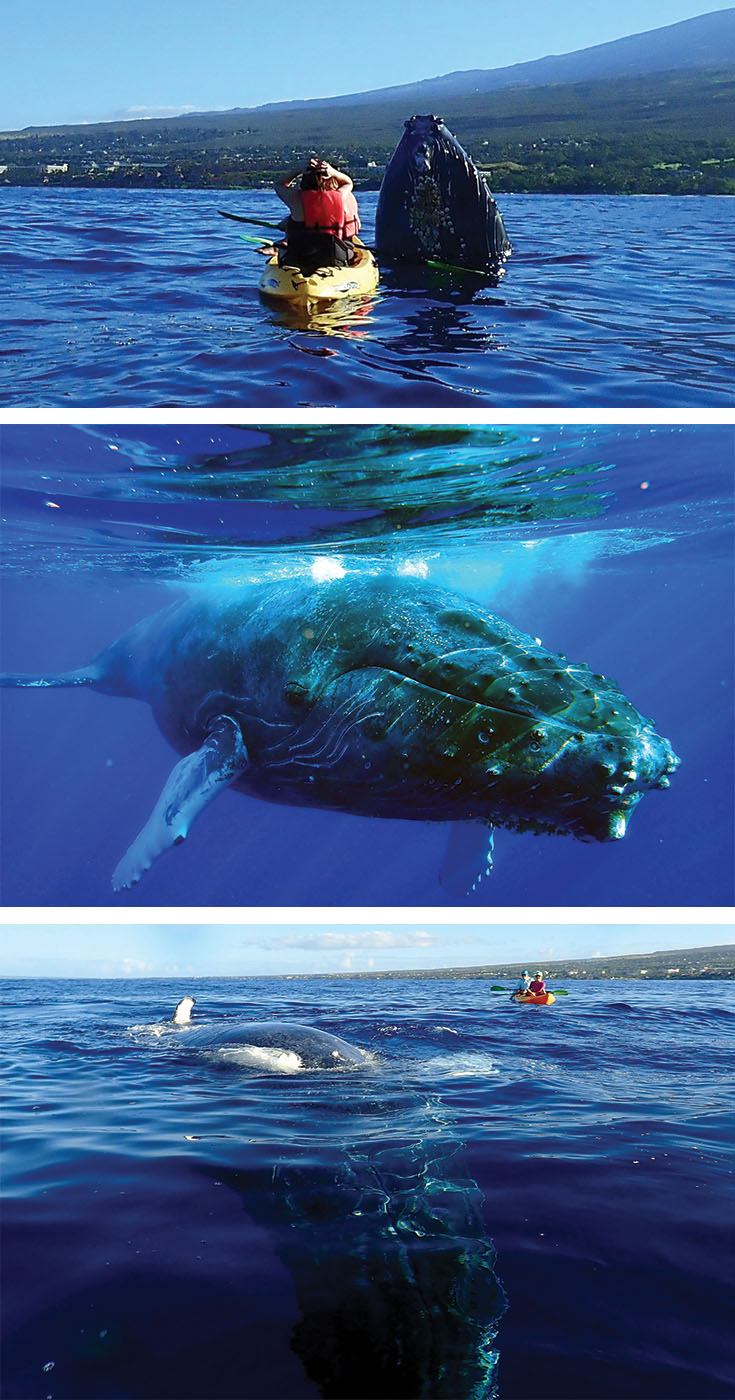
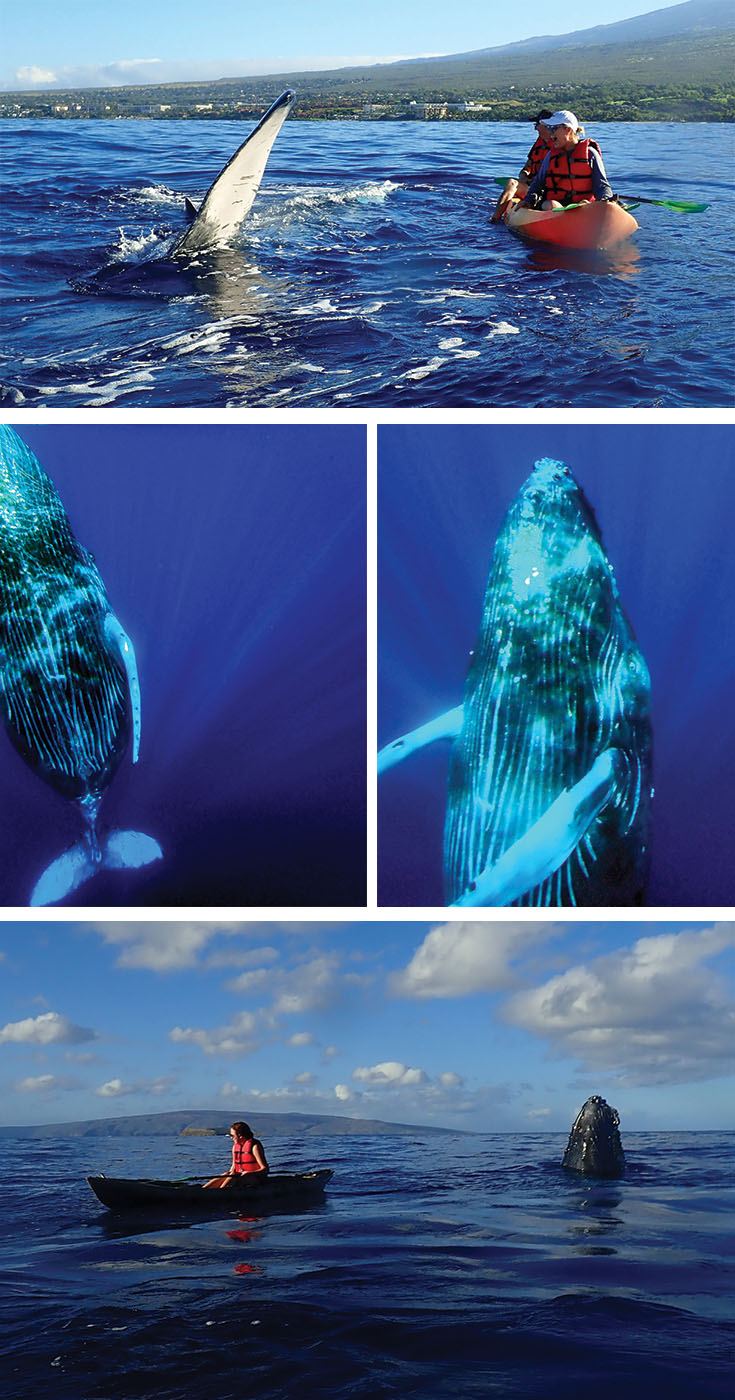
Some Of The Whale Behavior We Saw
Spy Hop
A whale will sometimes pop its head out of the water so as to get a better look at something on the surface. Whales have incredibly powerful eye muscles that allow them to see both in and out of the ocean. We have never seen one come this close to a kayak, making it an incredibly exciting experience.
Pec Slap
When a whale lays on its side and slaps its pectoral fin on the surface of the water, it is called a “pec slap.” Occasionally we see whales at the surface on their backs slapping both pec fins one at a time.
Spout
Whales need to breathe and the blowhole of a whale could be compared to nostrils. They do not have water in their lungs and therefore are not blowing a stream of water through their blowholes. What you see is an expulsion of hot moist air that when combined with the water that collects outside their blowholes hits the cooler outside air, a mist is formed. A spout is a pretty good indicator of where a whale is and multiple spouts give us insight into how many might be in the area.
Other Common Humpback Whale Behaviors
Sounding Dive
We all love seeing the beautiful tail of a whale above the surface. The only downside of this behavior is that it indicates that the whale is diving down and not likely to resurface for about 15 or so minutes.
Breach
The touchdown of whale watching is the breach. A breach is when a whale leaps out of the water and lands on its side, making a huge splash. There are many theories surrounding the breach.
- Having fun: Maybe but considering the amount of energy it would take the fasting 90,000 lb animal to complete such a feat, some believe having fun is not likely.
- Communication: After the 90,000 lb whale comes down from its jump, just imagine the sound and how loud it must be under the water. Some scientists have noticed breaching increases when whales are at least 2.5 miles apart, so if you see a breach, there’s a chance you will see a response breach a couple miles away.
- Cleaning: Whales have barnacles on their skin and breaching is potentially a method of shaking them off.
- See what’s above the water: Jumping out of the water albeit short-lived, may be a way for a whale to see what is going on out of the water.
- Signal presence: a breach is likely a very effective way to signal a whale’s presence to others.
Our new friend did not breach the day it came up to say hello.
More Things to Know About Humpback Whales in Maui
Whales typically start to show up in Maui waters sometime in late October. Approximately 12,000 humpback whales swim the whopping 3,000+ miles from Alaska to Hawaii to mate, give birth and/or nurse their young in the waters around Hawaii. That is one of the longest migrations of any mammal! Imagine swimming from La to Maui… So what’s the allure? Hawaiian waters are not more than 600 feet deep and clean, making it easier for them to see predators. The water temperature is warmer than say Alaska which is important for thermoregulation. Newborn whales do not have fat built up to keep them warm and since mothers are not feeding, they do not want to waste energy on keeping warm.
Kohola is the Hawaiian word for humpback.
What Do Whales Eat?
Humans. NOT!!! Now that we have your attention, you should know Humpback whales do not eat while visiting Hawaii. Humpback whales are filter feeders so when they do eat, they chow down on krill, tiny fish, and plankton.
Where Do Whales Mate and Give Birth?
Maui! Female humpback whales also migrate to Japan and Mexico and we think they return to birth their calves in the same location as they conceived. We already mentioned what they do here, but it is important to point out these things do not all happen in one visit. Gestation is approximately 11-12 months. They breed one year, come back to birth the next and come back yet again to wean their yearlings. Though the bond between mother and calf is consistent, that of the male and female is not. Whales are polygamous and do not mate with the same partner year after year. If you see a mom and calf with a male escort, it is most likely not the “baby daddy.”
Males form competition pods where they show off their valor in order to gain the attention of a female whale. If you see several spouts and lots of surface activity, chances are there’s a competition pod happening. These competitions are not only comprised of what you see at the surface, rather they may involve up to twenty whales! The group is very fluid with a revolving door of losers departing and new hopeful suitors arriving.
Do Whales Sing?
Yes, sort of. They do not actually have vocal chords. Whales do, however, make a sort of song lasting about twenty minutes that they “sing” repeatedly. Humpback trivia: Do all whales sing? Answer: no. Only male humpback whales sing and that song is considered to be one of the most complex non-human acoustic displays in the animal kingdom. Like most things with whales, we do not actually know why they sing. Some theories include attracting females, warning or threatening other males, establishing territory, and quite the opposite, they sing as a means of establishing a buddy system.
[jwplayer player=”2″ mediaid=”1510″]
How Do Whales Breathe?
Humpback whales breathe similarly to us, but they are conscious breathers, meaning they have to actually think about breathing. When they sleep, they turn off only half their brain and the active part monitors breathing. Sounds exhausting right? Think about this: humpback whales can dive up to 700 feet below the surface, and hold their breath for up to 45 minutes. However, the typical adult will come up for air every 10 to 15 minutes.
How Long Do Whales Live?
Humpback whales have the potential to live between 45 to 50 years, but some studies indicate they could live upwards of 90 years. The current population is estimated to be 90,000 worldwide, with the North Pacific population at around 20,000 – 22,000 and Hawaii breeding grounds somewhere between 10,000 -12,000.
Maui Whale Watching
One of our favorite times of year is Whale Season, and we always encourage our guests to join us for a unique experience on the water to see these amazing animals in action on one of our whale watching kayak tours. Skip the large boat tour and join us for a much more intimate, personalized whale watching experience from a kayak.
Mahalo for reading, and please share your best Hawaii whale watching experience (so far) in the comments below. Hope to see you on the water with us soon!
61 Halekuai St., Unit 2






